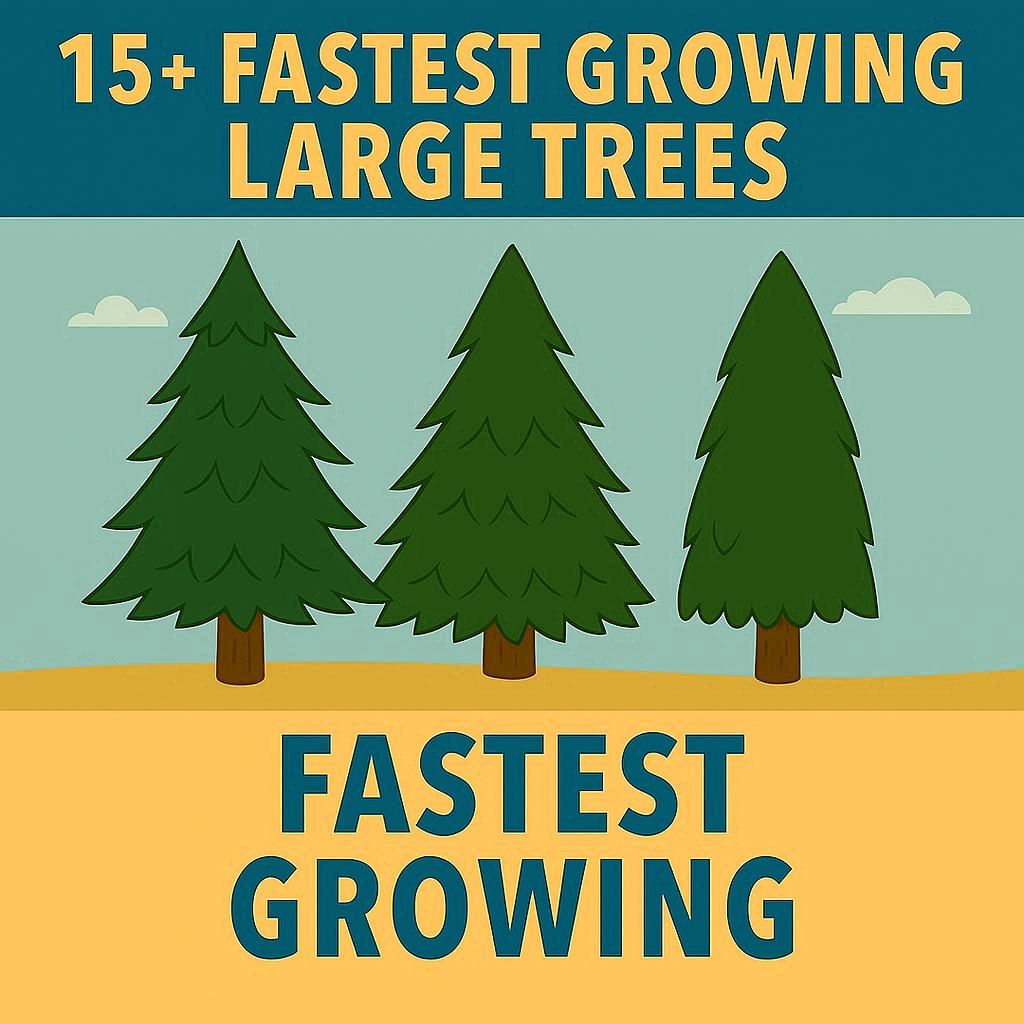
When it comes to landscaping, privacy screens, or reforestation, fast-growing large trees are the go-to solution. They add beauty, shade, and structure to any property while improving air quality and supporting wildlife. The key is to choose species that not only grow fast but also thrive in your local climate and soil conditions.
Below are some of the fastest-growing large tree species, along with where they grow best.
Why Fast-Growing Trees Rock?
Fast-growing trees solve lots of problems quickly. They create shade for your house (which saves money on air conditioning), give wildlife a home, clean the air, and make your yard look amazing in record time. Most of these trees grow 3 to 8 feet every single year—that’s taller than most adults!
What Makes These Trees Grow So Fast?
Fast-growing trees share some cool tricks. They put energy into height instead of super-dense wood, which means they reach the sky faster but sometimes have weaker branches. Many love water and grow near streams or in moist soil where their roots drink up nutrients easily. Trees like eucalyptus never go fully dormant—they keep growing whenever it’s warm enough, unlike trees that sleep through winter.
🌳 1. Hybrid Poplar (Populus deltoides × Populus nigra)
- Growth Rate: 5–8 feet per year
- Mature Height: 40–60 feet
- Regions: Most of the U.S., except extreme South and desert regions
- Notes: Hybrid Poplars are among the fastest-growing shade trees, perfect for windbreaks or quick privacy screens. They prefer full sun and moist, well-drained soil.
🌲 2. Silver Maple (Acer saccharinum)
- Growth Rate: 3–7 feet per year
- Mature Height: 50–100 feet
- Regions: Eastern and Central U.S.
- Notes: Silver Maples are known for their beautiful silver-backed leaves and rapid growth. Ideal near large open spaces but should be planted away from structures due to shallow roots.
🌳 3. Weeping Willow (Salix babylonica)
- Growth Rate: 4–8 feet per year
- Mature Height: 35–70 feet
- Regions: Nationwide, especially near water bodies
- Notes: These graceful trees thrive in wet soils and make excellent landscape features near ponds or lakes. They need ample space and water.
🌲 4. Green Ash (Fraxinus pennsylvanica)
- Growth Rate: 2–5 feet per year
- Mature Height: 50–70 feet
- Regions: Eastern and Central North America
- Notes: A tough, adaptable tree with brilliant fall color. Resistant to many soil types but now threatened by the emerald ash borer in some regions.
🌳 5. Tulip Poplar (Liriodendron tulipifera)
- Growth Rate: 3–5 feet per year
- Mature Height: 70–90 feet
- Regions: Eastern U.S.
- Notes: Known for its straight trunk, tulip-shaped leaves, and stunning yellow flowers. It prefers deep, moist, well-drained soil and full sunlight.
🌲 6. Dawn Redwood (Metasequoia glyptostroboides)
- Growth Rate: 2–4 feet per year
- Mature Height: 70–100 feet
- Regions: Eastern U.S., Pacific Northwest
- Notes: A living fossil once thought extinct, this deciduous conifer grows quickly and has a striking pyramidal shape. Tolerates wet or clay soils.
🌳 7. Northern Catalpa (Catalpa speciosa)
- Growth Rate: 2–4 feet per year
- Mature Height: 50–80 feet
- Regions: Central and Eastern U.S.
- Notes: Notable for its large heart-shaped leaves and showy white flowers. It grows well in most soils and provides excellent summer shade.
🌲 8. Eucalyptus (Eucalyptus spp.)
- Growth Rate: 6–10 feet per year
- Mature Height: 60–100+ feet
- Regions: Southern U.S., coastal California, Australia
- Notes: Eucalyptus trees are some of the world’s fastest-growing hardwoods, thriving in warm, frost-free regions. Their aromatic leaves and tall form make them popular ornamental and timber trees.
🌳 9. Lombardy Poplar (Populus nigra ‘Italica’)
- Growth Rate: 5–9 feet per year
- Mature Height: 40–60 feet
- Regions: U.S. and Europe (temperate climates)
- Notes: Known for its narrow, upright shape and very fast growth. Excellent as a windbreak or privacy screen but short-lived (typically 15–25 years).
🌲 10. Douglas Fir (Pseudotsuga menziesii)
- Growth Rate: 2–4 feet per year
- Mature Height: 70–250 feet
- Regions: Western U.S. (Pacific Northwest)
- Notes: A massive evergreen tree used for timber and Christmas trees. It thrives in cool, moist climates and acidic soils.
🌳 11. Sycamore (Platanus occidentalis)
- Growth Rate: 3–6 feet per year
- Mature Height: 75–100 feet
- Regions: Eastern U.S.
- Notes: Recognized by its mottled bark and large leaves, the Sycamore is both fast-growing and long-lived. Ideal for large properties or parkland.
🌲 12. Giant Sequoia (Sequoiadendron giganteum)
- Growth Rate: 2–3 feet per year
- Mature Height: 150–300 feet
- Regions: Western U.S. (California and Pacific Northwest)
- Notes: The largest trees in the world by volume. They require full sun and deep, well-drained soil. Ideal for parks and open landscapes.
🌳 13. Southern Live Oak (Quercus virginiana)
- Growth Rate: 2–3 feet per year (young), slower when mature
- Mature Height: 40–80 feet
- Regions: Southeastern U.S.
- Notes: An iconic southern tree with sprawling limbs and evergreen leaves. Slow to start but grows rapidly once established.
🌲 14. Bald Cypress (Taxodium distichum)
- Growth Rate: 2–3 feet per year
- Mature Height: 50–120 feet
- Regions: Southeastern U.S., especially swampy areas
- Notes: A water-loving conifer that thrives in wet soils and floodplains. Its “knees” (root structures) help stabilize it in saturated soil.
🌳 15. Red Maple (Acer rubrum)
- Growth Rate: 3–5 feet per year
- Mature Height: 40–70 feet
- Regions: Eastern U.S.
- Notes: Popular for its vivid red fall foliage and adaptability to various soils. Commonly planted in suburban areas for shade and beauty.
🌎 Summary: Where They Grow Best
| Region | Best Fast-Growing Trees |
|---|---|
| Northeast U.S. | Red Maple, Silver Maple, Tulip Poplar, Catalpa |
| Southeast U.S. | Live Oak, Bald Cypress, Willow, Hybrid Poplar |
| Midwest U.S. | Green Ash, Silver Maple, Hybrid Poplar |
| West Coast | Eucalyptus, Douglas Fir, Dawn Redwood |
| Southwest / Arid Areas | Hybrid Poplar (with irrigation), Eucalyptus |
🌿 Benefits of Planting Fast-Growing Large Trees
- Shade and Cooling: Reduces air-conditioning costs and urban heat.
- Wind and Noise Barriers: Acts as natural screens for privacy and sound.
- Wildlife Habitat: Provides nesting and food sources for birds and mammals.
- Erosion Control: Stabilizes soil on slopes or flood-prone areas.
- Carbon Sequestration: Absorbs CO₂, improving air quality.
Quick Comparison Chart
| Tree Name | Growth Per Year | Best Zones | Favorite Conditions |
|---|---|---|---|
| Hybrid Poplar | 5-8 feet | 3-9 | Moist soil, full sun |
| Weeping Willow | 3-8 feet | 4-10 | Wet areas, near water |
| Eucalyptus | 6-10 feet | 7-10 | Warm climate, well-drained soil |
| Tulip Poplar | 2 feet | 4-9 | Deep, rich soil, full sun |
| American Sycamore | 2-6 feet | 4-9 | Moist areas, adaptable |
| River Birch | 3 feet | 3-9 | Wet to moist soil |
| Red Maple | Fast | 3-9 | Very adaptable |
| Silver Maple | 3-7 feet | 3-9 | Moist soil preferred |
| Northern Red Oak | Moderate-Fast | 3-8 | Well-drained, acidic soil |
Important Things to Remember
Fast growth comes with trade-offs. Trees with softer wood (like silver maple and weeping willow) sometimes lose branches in ice storms or heavy winds. Some fast-growers develop aggressive roots that can mess with pipes or sidewalks, so plant them away from your house and underground utilities. But if you pick the right tree for your location and give it proper care, these speedsters will reward you with beauty and benefits for many years!
❓ Fast-Growing Large Trees FAQs
1. What is the fastest-growing large tree in North America?
The Hybrid Poplar is one of the fastest-growing, adding up to 8 feet per year under ideal conditions.
2. Which fast-growing trees provide the most shade?
Silver Maple, Tulip Poplar, and Sycamore have large, spreading canopies that offer excellent shade.
3. Are fast-growing trees weaker?
Generally, yes. Rapidly growing trees like poplars and willows may have weaker wood and shorter lifespans than slow-growing hardwoods like oak.
4. What’s the best tree for privacy that grows tall quickly?
The Lombardy Poplar and Hybrid Willow are top choices for quick-growing, tall privacy screens.
5. Which trees grow best in wet areas?
Weeping Willow, Bald Cypress, and Dawn Redwood thrive in moist or waterlogged soils.
6. Do fast-growing trees need special care?
Yes. They require regular watering, pruning, and fertilization, especially in their first few years to support healthy structure and strong roots.
🌳 Conclusion
Fast-growing large trees are the perfect choice for homeowners and land managers seeking quick results — whether for shade, beauty, or environmental benefits. From the hardy Hybrid Poplar to the majestic Tulip Poplar and Dawn Redwood, there’s a species suited for nearly every climate.
With the right selection and care, you can transform your landscape within just a few seasons — and enjoy decades of natural beauty, shade, and ecological value. 🌲🌎
Check sources
